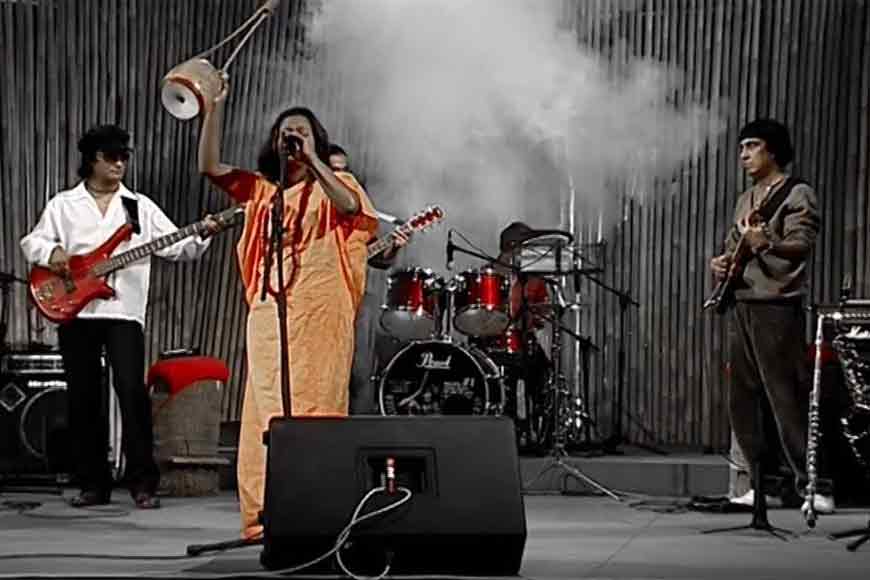Let’s look out for a true baul on World Music Day

I met Bishnupada way back in 2009 in the middle of an Aila-ravaged Sunderbans. The super-cyclone had destroyed both lives and homes in a whiff, but somehow could not dampen the free-spirited baul, who I met in the middle of nature’s fury.His dedication in bringing the broken homes to shape, was as strong as his music, celebrating the spirit of the soul. Far from the urban landscape where music is made primarily used as a profitable commodity, I was here crossing the mighty Bidyadhari River, to reach Bishnupada Baul in remote Dayapur village.
I arrived at Dayapur, towards the afternoon, completely exhausted from the long drive to Basanti and a motor boat (bhotbhoti) ride across Bidyadhari. Even a month after Aila struck, saline water had not receded from the fields, with a heavy stink of rotten paddy in the air. Water was still flowing into the villages through breached embankments.
At the centre of this ravaged land, stood one building, the Binapani High School, a centre for relief activity. The deafening sound of hammers for constructing a wooden shed made it worse and the buzzing of flies added to the overt sense of heat. While every political party was busy grabbing attention of the media for their ‘relief work,’ halogen tablets, ORS, tarpaulin sheets, dry milk and twice a day khichdi were being snatched by Aila victims to keep them alive.
In the midst of all this din and commotion Bishnupada had a serene and patient front. Clad in the traditional saffron robe and turban, here was this middle aged, high-boned sensitive man who had come all the way from the interiors of Birbhum to stand beside the victims. Bishnupada was not interested in ‘social work of creative people’ to get a Page 3 viewership.
“These people have been reduced to penury. Overwork, malnutrition, lack of food, lack of joy in life…” he said with a deep sense of concern and tenderness. I discovered a child of eight years, an orphan, beside him. Her tiny hands were red and swollen from the daily toil she too had to go through. Her eyes reflected the horror and dreadful shock of not finding her family. She wore a Holi colour smudged dress, presumably collected from the relief trucks. I am sure it was thrown from the upper floor balconies of posh Kolkata homes on moving relief vehicles. Sometimes nature even gives us opportunities for annual clearance of our wardrobes!
Bishnupada, apart from trying to weld together the rival factions of relief workers, was also attending to this child and showering her with love to calm her down. The sensitive soul also took decisive actions, streamlining the relief work. His terrific energy electrified me and all those who came within his radius. It was almost four in the evening. Volunteers were trying to scrub and clear utensils and other sundry jobs. Bishnu was nowhere to be seen then. After a day’s confinement within the school turned camp,watching him and occasionally following his instructions, I enquired about Bishnu.
Also Read
BAUL WHO WAS CALLED INDIA’S BOB DYLAN!
“He must be there by the river bank,” said a volunteer. I collected my stuff and went on a look out for him. ¬Sound of the dotara wafted through the breeze, with a singing voice pitched in soprano coming from a distance. I walked back along the bank, clustered with boulders. The voice turned clearer with every step I took. ‘Soda anonde thako mon…'--- his voice resonated far and wide. Even in this hour of calamity, he was advocating joy!
With the eight-year-old orphan by his side, Bishnu’s voice took me to a different world, where each word he uttered echoed his belief and conviction. He was encircled by some villagers but remained oblivious to them. He was in his own world. His next song: ‘Sotyo bolo, supothe cholo,' I took off my shoes for a better grip on the soil and stepped on to a plank to settle myself to be a part of his journey, a journey far from the reliability of organized routes, to an unusual and intriguing exploration. Here was this man who spent the entire day besides the Aila struck people, working to rebuild their lives along with singing for them.
Where are the Pabans,Kartiks, Subols and the Purnos? Where are those self-styled and self proclaimed “Khyapas” from our city, who strap around a Fender or a Gibson on the rented saffron robes from the theatre dress suppliers and pretend to be cultural saviors? Where are those musicians who try striking a synergy between Baul and Salsa, Soukous, Cajun, Calypso, Blues, Jazz or maybe Bluegrass? Where are those who try to find patterns and riffs in every dubki beat that they hear? Well, they are found in London and Paris shows, hardly along the red laterite soil of Birbhum. I wonder at times, if at all we know how to distinguish between a performance and a way of life portrayed through a performance.Who is the true baul? Presumably educated and sensible urban artists nurturing long hair and carefully pinned ear rings, representing Bengal folk culture in the United Nations and earning a living in a mechanical reproduction of their repertoire in front of an audience, or those like Bishnupada of Dayapur, who prefers singing songs of life to those who have lost? Trying to internationalise baul songs have often turned it into a mere commodity. It’s time we left Baul or any folk tradition to itself.
As I sat thinking of this urban commercialisation of music, he sang along: “Pakhi kokhon jani ure jay…” I wish somebody took the initiative to make such lyrics understood to hordes of guitarists/bassists before they thump on their instruments swayed by the 3/4 and 6/8 beats of the songs.I sit on the plank imbibing the evening calm. Bishnupada convinces me that baul does not mean an ektara poking in the sky, or mysterious speech, secret ways of sadhana, symbolic words, songs, ganja and all those elements that hide them behind a so-called ‘mystic world.’
Baul also doesn’t mean an object of research by our cultural intellectuals. My day here at Dayapur convinced me that Baul is a social behavior and his quest for love goes beyond all boundaries.I surveyed the surroundings. The last bhotbhoti was waiting for passengers –me being one of them. Another was slogging down the river with a banner of some Rotary club from Kolkata with members out for an ‘Aila tourism’, spending the day throwing relief material from the boat to villagers, instead of stepping on the banks.
It was time for me to take a leave. By now, Bishnupada was standing and singing and more villagers joined him. The child was fast asleep. I wanted to say a final good bye to him and the way up wasn’t a smooth go. But at times temptation gets better of caution. I reached him and waited for him to end the song. ‘Apnar sathe dekha hoye khub bhalo laglo, abar nishchoi dekha hobe…’ (Loved meeting you, maybe we shall meet again). I held his hand and felt the vibration of a true and ultimate baul. ‘Sada Anonde thako mon…, joy guru..’--- was his advice.
It was a spectacular Godhuli, perfect and intimate, that confused and triggered within me the ‘age borne’ purist in me. But it gave me the belief that this confusion could prove fertile. I did not have to transport myself to the most spectacular sunset images from around the world nor did I have to think of raga Purvi or Imon to take this Godhuli to heart. This evening was just mine.I was the last to board the bhotbhoti, much to the irritation of a few.
Bishnu started his next song ... “Dayal amar parer kandari…”
‘Joy Guru’, I shouted back instinctively.










